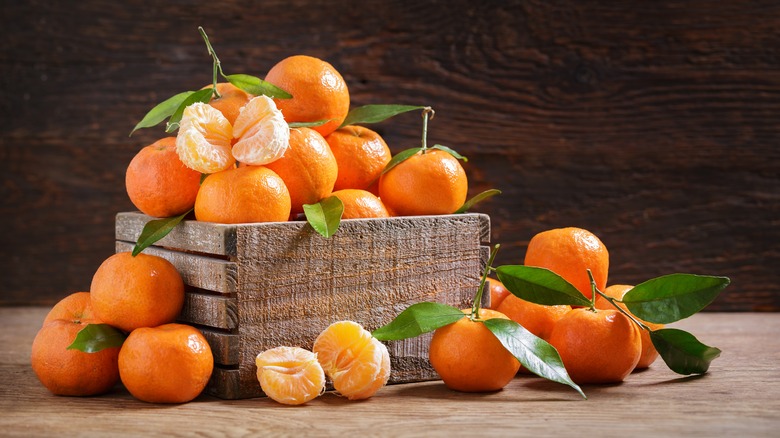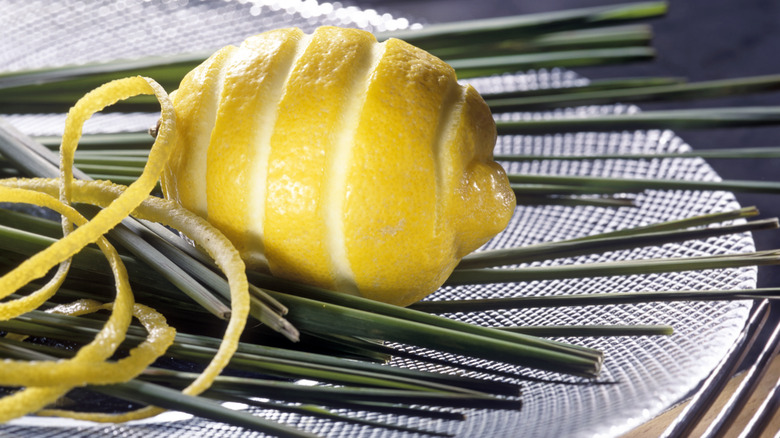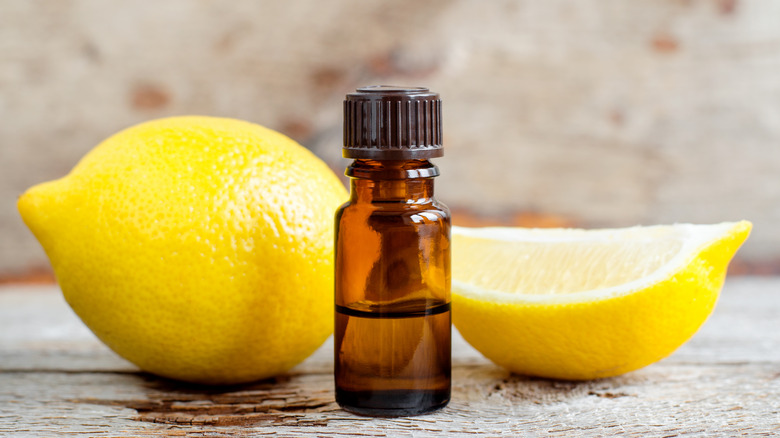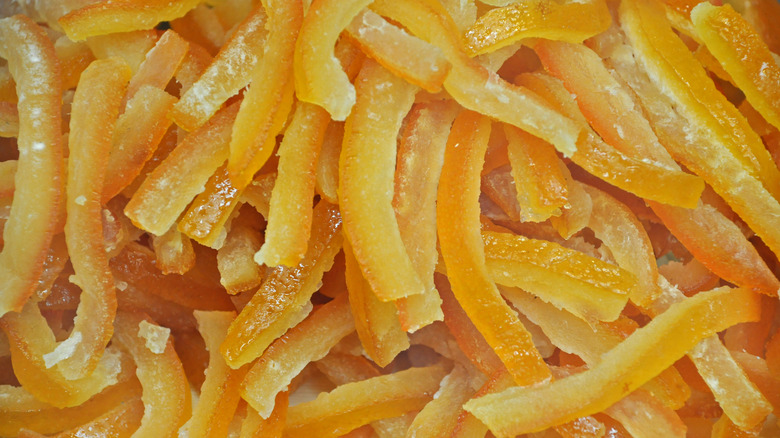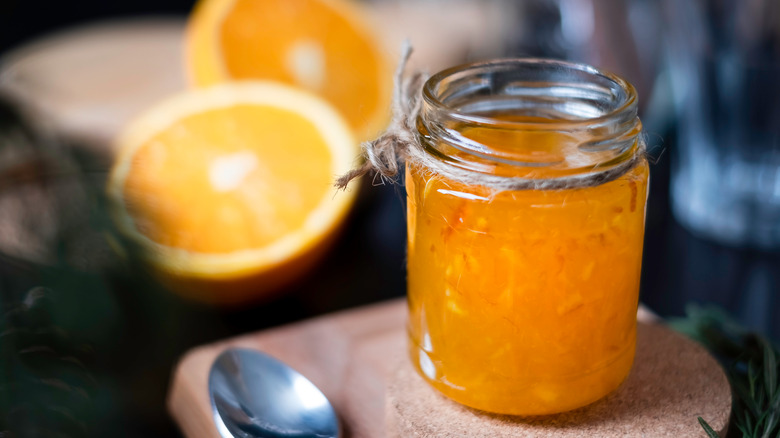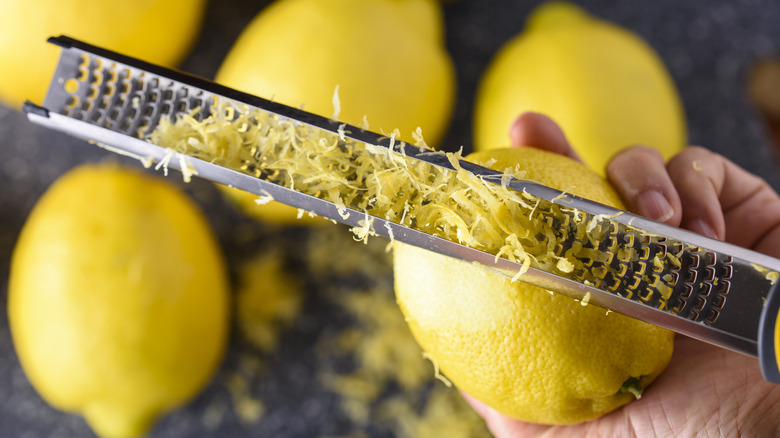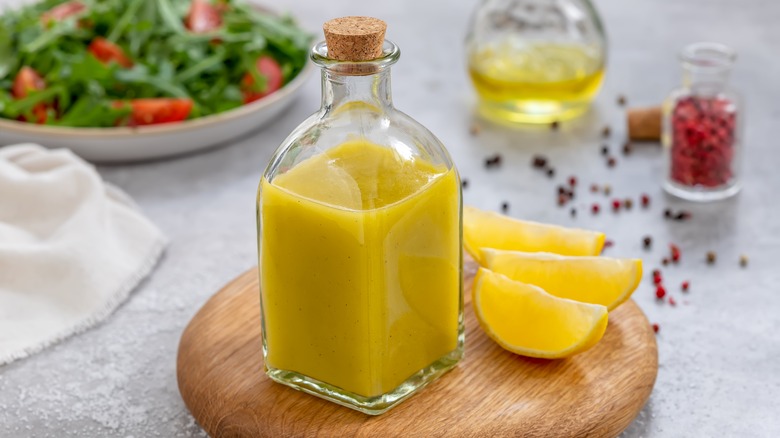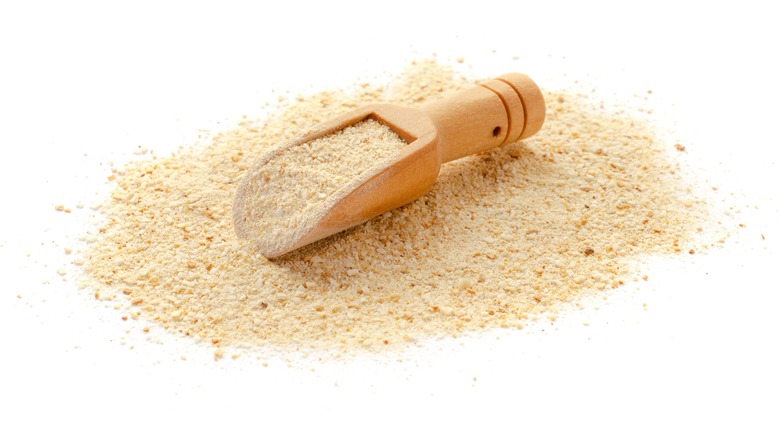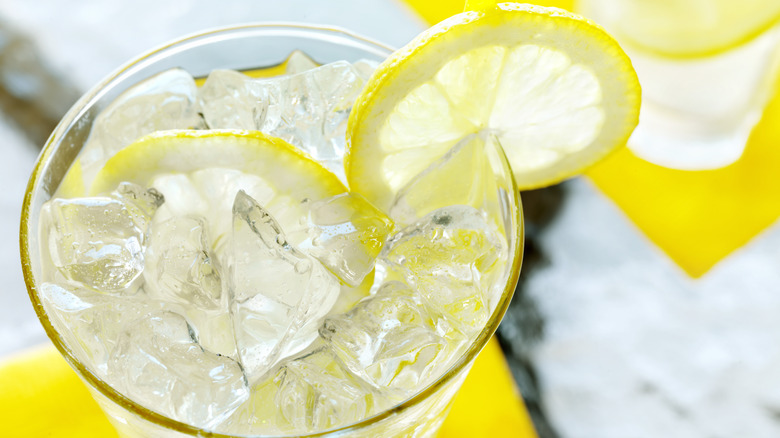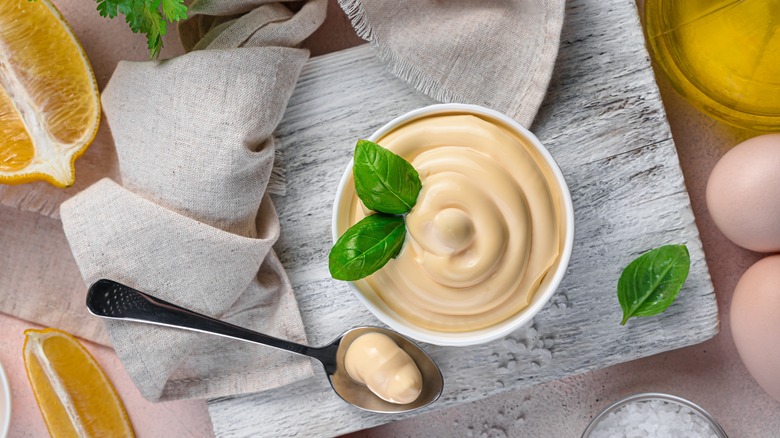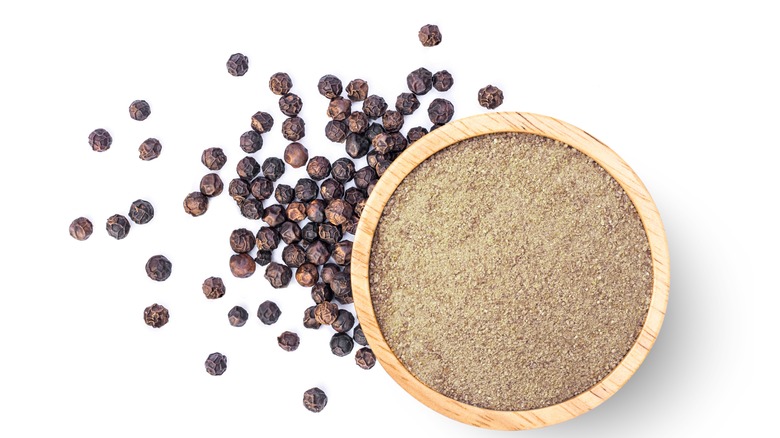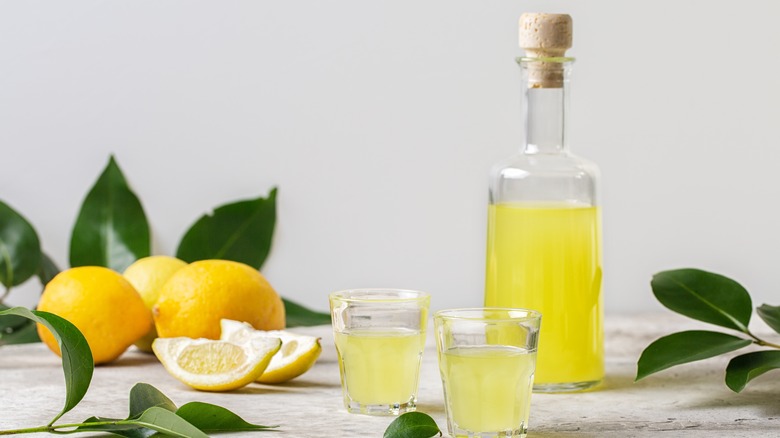No-Waste Tips To Make The Most Out Of Citrus Peels
Home cooks love having citrus on hand for any number of reasons. Besides being tasty and refreshing eaten on its own, it can be a powerful flavor booster when added to other dishes. Citrus fruits are also a great source of Vitamin C and other nutrients, and from a practical perspective, are great to have on hand because they're keepers; their thick, leathery peel protects them from the elements, so they stay fresh longer than other, more delicate fruit.
If you've ever zested a lemon or orange for a baking project or carved out a strip of lemon or lime peel for a cocktail, you know that citrus peels also smell amazing — to some, better than the juice of the fruit itself. In addition, they're even more nutritious than the rest of the fruit, if you can get past the bitterness; a single tablespoon of orange peel offers three times as much Vitamin C as the actual fruit. But unless you're making recipes that specifically call for it or are making a batch of cocktails, folks are far more likely to toss citrus peels than take full advantage of the flavor and nutrition they offer. Here are some fun ways to keep citrus peels out of the landfill while adding flavor to drinks, desserts, and more. Be aware, however, that much commercial citrus is coated in wax; while this is food safe, you'll get the best results if you wash it off first.
Dehydrate citrus peels to flavor drinks and food
If you enjoy adding a twist of lemon or lime zest to your cocktails, try making a shelf-stable supply of twists by dehydrating citrus peels. To do so, carefully remove the colorful outer layer of the peel (the white pith is too bitter for this purpose), lay it cut-side up on a baking tray, and allow to dry in open air for a few days, until stiff and brittle. Alternatively, you can bake them at low heat (200 degrees) for about 30 minutes.
You can use the dried peels the same way as fresh ones in cocktails, and like their fresh counterparts, they make an attractive, aromatic garnish. In addition, they make a great addition to herbal or spiced tea mixtures, mulled punch, and other hot drinks. Dried peels can also be used as a food seasoning. For example, dried tangerine peels are a traditional Chinese cooking ingredient. You might have tasted them without realizing it in favorite dishes like orange beef or chicken.
Macerate zest in vodka to make your own citrus extract
When most people imagine the signature aroma of a lemon, lime, or orange, what they actually have in mind is the scent of the oils in the peel. This is why many recipes for citrus-flavored cakes and other baked goods call for grated zest along with juice — while the juice alone will provide some aroma and tartness, it won't be enough to lend a truly distinctive flavor. This is also why many recipes call for citrus extracts when they really want a concentrated citrus flavor to come through.
Most supermarket extracts, however, taste and smell pretty generic; there's nothing wrong with them, but nothing special about them, either. But if you're lucky enough to find fresh citrus with a distinctive aroma you'd love to capture for future use, you can do this by making your own citrus extract. All you need to do is combine citrus zest and vodka, place it in a clean glass jar, and store in a dark area for about two months, shaking the jar occasionally to ensure the zest and vodka are combined. While proportions of citrus and vodka can vary, one recipe calls for the zest of three lemons and half a cup of vodka. Once it has reached your desired strength, strain it into a clean container for future cooking projects.
Candy your citrus peels for a sweet treat
If you love citrus and hate the idea of any of it going to waste, you're probably already a fan of candied citrus peel. No, it's not just for Christmas fruitcakes — it not only makes a great addition to baked goods all year long, it can add an original touch to trail mix and salads, as well as a fun cocktail garnish. Of course, a baton or two of chocolate-dipped candied orange or grapefruit peel is a classy (and breath-freshening) way to end a fancy meal.
While it looks fancy, candied citrus peel isn't hard to make. You just have to boil and rinse the sliced peels (pith and all) a couple of times to eliminate any bitterness, then cook them in sugar syrup until soft and translucent. Once they're cooked, toss the peels in sugar and leave them out to dry on a foil-lined baking sheet for a few days. You'll save a bit of money over the fancy store-bought versions — and best of all, you won't have to wait until Christmas to find them.
Make your own marmalade
Marmalade is arguably the classiest of the common fruit spreads. Its hint of bitterness under an intense citrus profile makes it feel more grown up than pedestrian strawberry jam or grape jelly, as does its gentle orange hue. At the same time, it is sweet and accessible enough to be enjoyed by kids — there's a good chance that your first introduction to citrus peel as an edible substance in its own right was a serving of marmalade on toast.
If you have a lot of citrus on hand and sustainability on your mind, marmalade is also a delicious way to ensure every bit of your citrus stash (except, perhaps, the seeds) gets put to good use. Just grind your citrus into a coarse pulp in a food processor and cook slowly with an equal weight of sugar. You can use any citrus or combination of citrus you like. Your finished marmalade can serve as much more than a sandwich spread — it can add flavor to plain yogurt, liven up a slice of pound cake, and serve as a flavorful addition to glazes for both sweet and savory dishes.
Use fresh zest to lighten fried foods
Lots of people know and love the scent of fresh citrus zest. But its power to elevate ordinary foods remains sadly unappreciated; far too often, citrus peels (and all their culinary potential) end up in the trash or compost heap after the juices have been extracted. This is a real waste. If you've already bought a bunch of citrus, you'll get the most bang for your buck — and improve your dining experience — by making use of as much of it as possible.
Take, for example, the case of fried food. If you're pan-frying fish or vegetables, you might have thought to cut a few lemon wedges to serve alongside the finished dish, for diners to squeeze over their servings at will. The tartness and freshness of lemon juice makes a great foil for rich, oily food — but what about the rest of the fruit? Next time, bump up the flavor profile even more by adding some finely-grated zest to any sauce the dish may include, or by garnishing the cooked dish with a sprinkling of freshly grated citrus zest — this simple move will not only add a pop of color to the dish, but take the flavor from good to great.
Add citrus zest to brine for a brighter flavor
When serious cooks want to be sure a cut of meat will be tender and flavorful all the way through, they turn to brining. The practice of brining — allowing meat or other food to soak in heavily salted, seasoned water — not only ensures every bite is properly salted (not overly salty, if done correctly), but transforms the texture of the meat. The salt denatures and partially unravels the meat's proteins, enabling the meat to better hold moisture and giving it a more tender texture.
Brining is also an easy way to add flavors, since whatever flavorings you put in the brine will be absorbed into the meat. Common additions to brine include sugar, spices, herbs, and/or fruit juices. If you're planning to add citrus juice to your brine in any case, why not add some of the zest as well? This will not only enable you to get more mileage out of your cut-up fruit, but further enhance the taste and aroma of your final dish.
Make lemon sugar with leftover lemon zest
Flavored sugars are a great way to add a little something extra to desserts and sweets, such as breakfast pastries. You've probably experienced how cinnamon sugar transforms a plain slice of bread into a crave-worthy piece of cinnamon toast or turns a plain baked apple or coffee cake into something special. But cinnamon isn't your only option. If you want to add some extra zing to your sweets, you can make good use of leftover lemon peels by making lemon sugar.
You simply stir finely grated lemon zest into some sugar (zest of one lemon for every two or three cups of sugar, according to your taste), allowing the mixture to sit uncovered to dry out any moisture from the zest. Alternately, you can blend the zest and sugar together in a food processor. Besides being a great garnish for lemon-flavored desserts, the sugar can also add extra punch to fresh fruit and to cocktails, and there's no rule saying you can't use other citrus to make flavored sugar, such as oranges or limes.
For a livelier breading, add zest to breadcrumbs
When people think of breaded foods, a few adjectives come to mind: crispy, toasty, perhaps a bit decadent. At their worst, they can be heavy and stodgy. In either case, they are unambiguously rich, which is why they're so often served with something bright and acidic for contrast, such as malt vinegar or ketchup.
A squeeze of fresh lemon juice is another useful accompaniment to breaded foods. But if the breading is already heavily seasoned or the food itself is strongly flavored, that little squeeze of lemon might register as a mere hint of tartness rather than as truly lemony. If you love lemons (or whatever citrus you're using) and want to embrace the interplay between the rich breading and tangy citrus even more, try adding some finely grated citrus zest to your breading before you coat and fry your food. The zest contains a more profound concentration of citrus flavor and aromatic compounds than the juice, contributing a lively touch of flavor and brightness to your finished dish.
Make citrus-infused vodka or tequila
Flavored vodkas have become trendy in recent years; you can easily find vodkas in any number of different flavors in a well-stocked liquor store. One reason for their popularity is that they serve as a convenient shortcut if you tend to make the same vodka drinks all the time. Why bother investing in both vodka and lemons for your go-to cocktail if you can just buy a bottle of lemon-flavored vodka instead?
But if you regularly keep lemons in your kitchen, you can save a few pennies and make better use of your supply by making your own lemon-infused vodka. Combine vodka with an equal volume of lemon zest and allow the mixture to infuse for three to five days, shaking or stirring it occasionally to help distribute the flavors. To mix things up, you can use a different citrus or combination of citrus, or even switch out the vodka for another spirit (lime-infused tequila is another fun option). Homemade citrus vodka or tequila is not only nice to have in your home bar, but makes a festive (and easy) gift as well.
Citrus zest can add zing to store-bought mayo and other sauces
Cooks know it's not that hard to make homemade mayonnaise. But many home cooks don't bother because for most purposes, the store-bought stuff works and tastes just fine. Ditto pantry staple sauces such as ketchup and mustard; you can theoretically make them yourself, but unless you're seriously into canning or culinary experimentation, it's probably not worth the trouble.
Dependable as these kitchen warhorses are, after a while they can get a bit boring. The ever-increasing lineup of flavored ketchups and mayonnaise variants on supermarket shelves speaks to a craving for a change-up. It's fun to see, but frugal cooks can't help perusing the condiment aisle thinking "why should I buy Sriracha-flavored ketchup when I already have bottles of Sriracha and ketchup at home that I can mix together?" If this sounds like you, and you want to add your own personal touch to condiments without the commitment of a day-long canning project, here's another easy hack: add finely grated citrus zest to whatever bottled sauce you're using. The added freshness and flavor will make your familiar pantry sauce taste new again.
Make your own lemon pepper
If your wing order of choice isn't buffalo or barbecue but lemon pepper, you'll be pleased to know it's easy to make your own lemon pepper at home. Yes, you can always buy some, but making your own takes mere minutes and gives you more control over the final flavor profile. It also guarantees the mixture will taste fresh, and as an added bonus, will enable you to make use of any lemon peels you may have around.
To make lemon pepper, combine lemon zest and crushed peppercorns. Spread the mixture onto a parchment-lined baking sheet and bake on low until the zest is completely dry. Grind the mixture in a spice grinder to your desired consistency, then add salt to taste if you like. Besides being great on chicken wings, it's also a delicious way to punch up roasted vegetables, marinades, and pasta sauces — basically, it works anywhere you think a bit of acidity and brightness would make things better.
Limoncello is a great way to use up lemon zest – and end a festive meal
Your first sip of a well-made limoncello can feel like some kind of crazy miracle. How can the essence of a freshly picked lemon be so perfectly captured in a glass of liqueur? The answer is lemon peels — lots of lemon peels.
Since the peel is where most of the essential oils that give lemons their aroma are concentrated, smart mixologists figured out long ago that it was more efficient to use them, rather than plain lemon juice, to create a powerfully-flavored drink.
Making limoncello is easier than you might think. First, you'll need the zest of 10 lemons and a bottle of vodka — the stronger the vodka, the more efficiently it will pull the flavors from the zest. Combine the zest and vodka in a 1-quart glass jar, cover, and allow to infuse in a dark space for between four days and a month (infuse longer if you want a more intense flavor). Strain the mixture and sweeten the infused vodka to taste with a simple syrup made from equal volumes of sugar and water.
Once your limoncello is sweetened to your taste, bottle it and store it in the refrigerator or freezer. This could be a fun, easy side project for reducing waste if you're already making something that requires a lot of lemons, such as a pie or large quantity of marinade.

